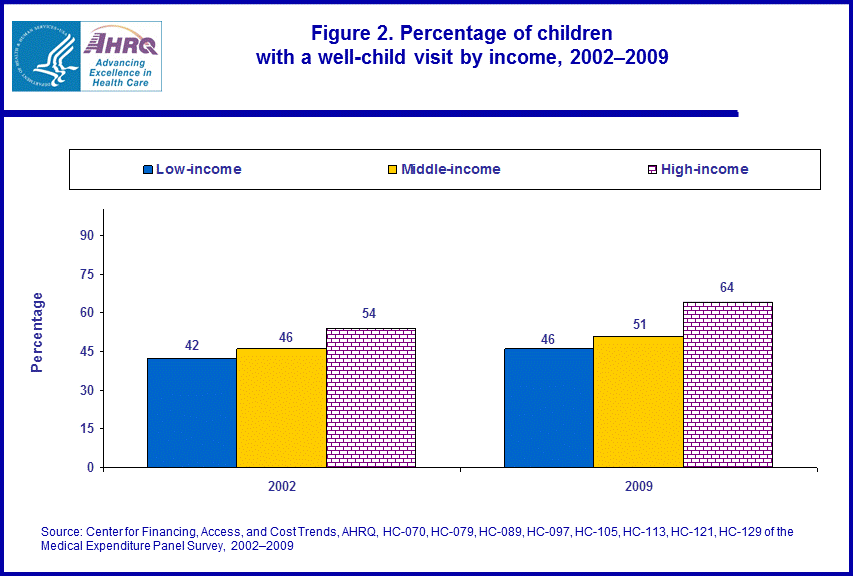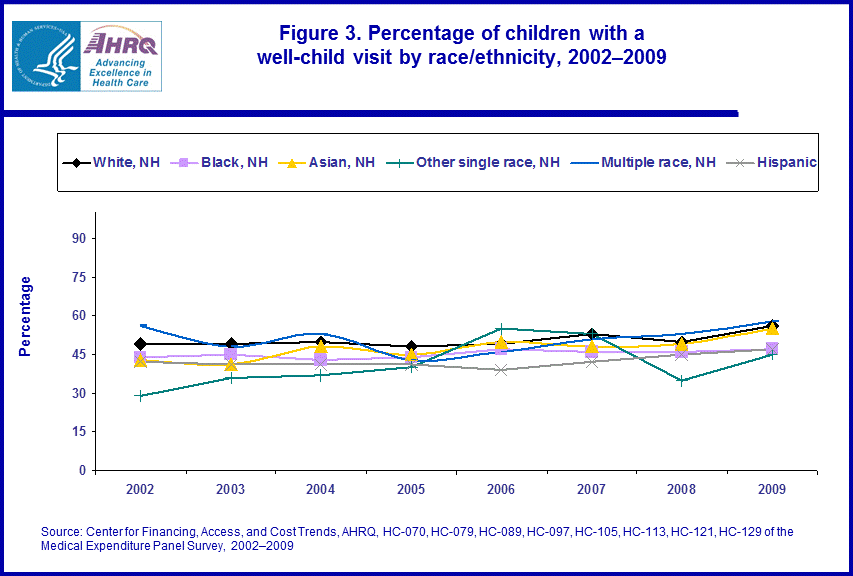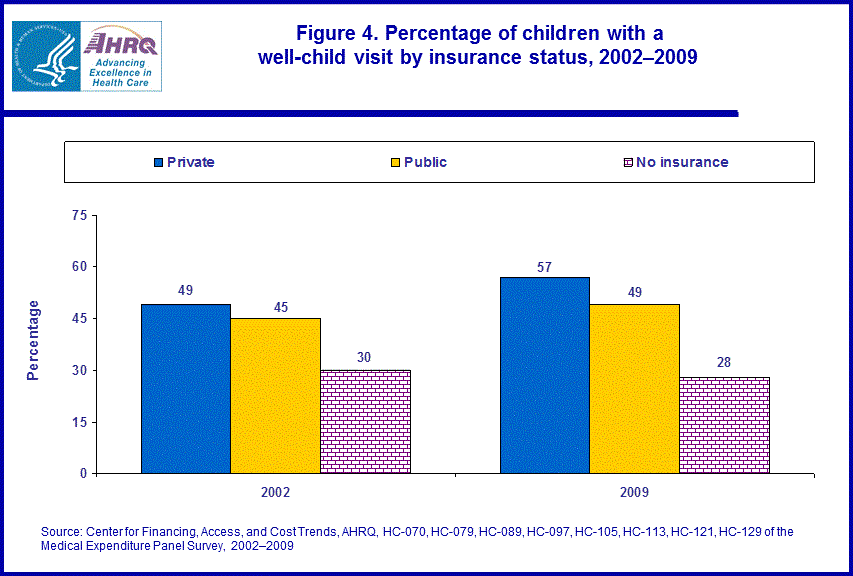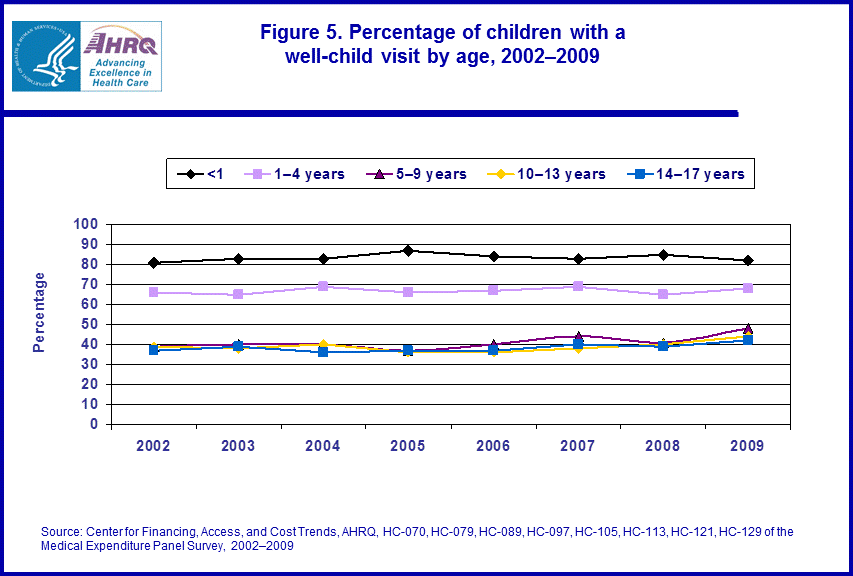
|
|
Font Size:
|
||||
|
|
|
|
||||
STATISTICAL BRIEF #419:
Trends in Well-Child Visits: United States, 2002-2009
Highlights
- Overall, the percentage of children who had a well-child visit during the year increased between the years 2002 and 2009.
- Between 2002 and 2009, the percentage of Asian children who had a well-child visit increased from 43 to 47 percent. Rates of well-child visits improved for whites, Hispanics, and other single races as well.
- Black children and children reporting multiple-racial identities did not statistically significantly increase their rates of well-child visits between 2002 and 2009.
- Children who were uninsured or had only public insurance were less likely to have an annual well-child visit, compared to children with private insurance.
- Increases in well-child visit rates occurred for children in older age groups. In 2002, 39 percent of children ages 10-13 had a well-child visit, compared to 44 percent in 2009. Among 14-17 year olds in 2002, 37 percent had a well-child visit, compared to 42 percent in 2009.
Introduction
Regular preventive health visits are designed to reduce the risk of serious disease and injury among children. Annual well-child visits can include several different kinds of care. For purposes of this Statistical Brief we define an annual well-child visit as a visit associated with any of the following reasons for seeing a health care provider: a general physical examination, immunizations/shots, or a well-child exam. Prior research based on MEPS data used this definition of well-child visits (Selden 2002). The main focus of this Statistical Brief is on exploring variations in preventive health care utilization for children by socio-economic factors including race/ethnicity, insurance status, and household income.Using the Household Component of the Medical Expenditure Panel Survey (MEPS-HC), this Statistical Brief examines children, ages 0–17 of the U.S. civilian noninstitutionalized population, and the percentage who report at least one office-based or out-patient hospital visit for general checkups, immunizations, or well-child visits from 2002–2009. All differences discussed in the text are statistically significant at the 0.05 level or better.
Findings
From 2002 to 2009, there was a statistically significant increase in the percentage of children (ages 0–17) who had a well-child visit during the year. In 2002, 46 percent had a well-child visit, compared to 52 percent of children in 2009 (figure 1).The percentage of children with an annual well-child visit increased for all income groups (figure 2). In 2002, among low-income children, 42 percent had a well-child visit compared with 46 percent in 2009. Among high-income children, 54 percent had a well-child visit in 2002 compared with 64 percent in 2009.
From 2002 to 2009, the percentage of children with well-child visits increased for whites, Asians, other single race children, and Hispanics (figure 3). For example, in 2002, 43 percent of Asian children had a well-child visit, compared with 47 percent in 2009. Black children and children reporting multiple-racial identities did not statistically significantly increase their rates of well-child visits between 2002 and 2009.
Overall, in every year between 2002 and 2009, children over the age of four were less likely to have a well-child visit during the year than younger children. The likelihood of having a well-child visit did increase over time for older children. In 2002, 39 percent of children age 10–13 had a visit, compared to 44 percent in 2009. Among 14–17 year olds in 2002, 37 percent had a well-child visit, compared to 42 percent in 2009 (figure 5). It is possible that this increase is related to the HPV vaccine availability in 2006. For younger children the likelihood of having a well-child visit did not change over this time period.
Data Source
Estimates for this Statistical Brief come from the MEPS-HC Full Year Consolidated Data File for 2002 (HC-070), 2003 (HC-079), 2004 (HC-089), 2005 (HC-097), 2006 (HC-105), 2007 (HC-113), 2008 (HC-121), 2009 (HC-129). Additionally we used the Office-Based Medical Provider Visits Event File for 2002 (HC-067G), 2003 (HC-077G), 2004 (HC-085G), 2005 (HC-094G), 2006 (HC-102G), 2007 (HC-110G), 2008 (HC-118G), 2009 (HC-126G). We also used the Hospital Outpatient Visit File for 2002 (HC-067F), 2003 (HC-077F), 2004 (HC-085F), 2005 (HC-094F), 2006 (HC-102F), 2007 (HC-110F), 2008 (HC-118F), 2009 (HC-126F). All estimates are restricted to children age 0-17 years of age. Annual well-child visit captures the percentage of children who had at least one office-based or out-patient hospital visit for general checkup (VSTCTGRY=1), immunizations (VSTCTGRY=6) or well-child exam (VSTCTGRY=9) as the main reason for the visit. The variables used for comparisons of children with a well-child visit are insurance coverage, income, and race INSCOV, POVCAT, and RACEX respectively. All estimates are weighted to represent the civilian noninstitutionalized population of children in the United States. Standard errors for all estimates are adjusted for complex survey design using the SVY commands in Stata 12.1.Definitions
Annual well-child visit: For each child, reasons for visits to an office-based provider or out-patient hospital provider were examined. If at any time during the year a child had a visit for general checkups, immunizations/shots, or well-child exam, they were defined as having an annual well-child visit.Health insurance status
Respondents were asked about health insurance coverage for themselves and all household members at each round of interviewing. Persons were classified according to whether they had any private health insurance during the year, public coverage only during the year, or were uninsured all year:
- Private: Persons having insurance at any time during the year that provided coverage for hospital and physician care from a nonpublic source. Coverage only by private single-service plan (e.g., coverage for dental or vision care only or coverage for accidents or specific diseases) was not defined as private health insurance.
- Public only: Persons who were never covered by private insurance during the year but who were covered at any time by Medicaid, State and local medical assistance programs, and TRICARE (which covers retired members of the uniformed services and the spouses and children of active-duty military).
- Uninsured: Persons with neither public nor private insurance coverage throughout the calendar year.
Classification by race and ethnicity was based on information provided by the household respondent for each household member. The respondent was able to describe each person's race by specifying any combination of races that applied (i.e., multiracial). Respondents were asked if each person's main national origin or ancestry was Puerto Rican, Cuban, Mexican, Mexicano, Mexican American, or Chicano; other Latin American; or other Spanish. Persons claiming a main national origin or ancestry in one of these Hispanic groups, regardless of racial background, were classified as Hispanic. Since the Hispanic grouping can include children of any race, the race categories exclude Hispanics.
Income
Income is expressed in terms of poverty status, the ratio of the family's income to the Federal Poverty thresholds, which control for the size of the family and the age of the head of the family. In this Statistical Brief, the following classifications are used: Low Income (<200% FPL), Middle Income (200–399% FPL), and High Income (400%+ FPL).
About MEPS-HC
MEPS-HC is a nationally representative longitudinal survey that collects detailed information on health care utilization and expenditures, health insurance, and health status, as well as a wide variety of social, demographic, and economic characteristics for the U.S. civilian noninstitutionalized population. It is cosponsored by the Agency for Healthcare Research and Quality and the National Center for Health Statistics.References
For a detailed description of the MEPS-HC survey design, sample design, and methods used to minimize sources of nonsampling error, see the following publications:Cohen, J. Design and Methods of the Medical Expenditure Panel Survey Household Component. MEPS Methodology Report No. 1. AHCPR Pub. No. 97-0026. Rockville, MD. Agency for Health Care Policy and Research, 2001. http://www.meps.ahrq.gov/mepsweb/data_files/publications/mr1/mr1.shtml
Cohen, S. Sample Design of the 1996 Medical Expenditure Panel Survey Household Component. MEPS Methodology Report No. 2. AHCPR Pub. No. 97-0027. Rockville, MD. Agency for Health Care Policy and Research, 2001. http://www.meps.ahrq.gov/mepsweb/data_files/publications/mr2/mr2.shtml
Cohen, S. Design Strategies and Innovations in the Medical Expenditure Panel Survey. Medical Care, July 2003: 41(7) Supplement: III-5–III-12.
Ezzati-Rice, T.M., Rohde, F., Greenblatt, J. Sample Design of the Medical Expenditure Panel Survey Household Component, 1998–2008. Methodology Report No. 22. March 2008. Agency for Healthcare Research and Quality, Rockville, MD. http://www.meps.ahrq.gov/mepsweb/data_files/publications/mr22/mr22.shtml
Selden, Thomas M. Compliance with well-child visit recommendations: evidence from the Medical Expenditure Panel Survey, 2000–2002. Health Services Research: e1766–e78.
Suggested Citation
Caldwell, J. Berdahl, T. Trends in Well-Child Visits: United States, 2002–2009. Statistical Brief #419. August 2013. Agency for Healthcare Research and Quality, Rockville, MD. http://meps.ahrq.gov/mepsweb/data_files/publications/st419/stat419.shtmlAHRQ welcomes questions and comments from readers of this publication who are interested in obtaining more information about access, cost, use, financing, and quality of health care in the United States. We also invite you to tell us how you are using this Statistical Brief and other MEPS data and tools and to share suggestions on how MEPS products might be enhanced to further meet your needs. Please email us at MEPSProjectDirector@ahrq.hhs.gov or send a letter to the address below:
Steven B. Cohen, PhD, Director
Center for Financing, Access, and Cost Trends
Agency for Healthcare Research and Quality
540 Gaither Road
Rockville, MD 20850
 |
||||||||||||||||||||||||||||||||||||||||||||||||||||||||||||||||||||||||
|
||||||||||||||||||||||||||||||||||||||||||||||||||||||||||||||||||||||||
|
|
||||||||||||||||||||||||||||||||||||||||||||||||||||||||||||||||||||||||
 |
||||||||||||||||||||||||||||||||||||||||||||||||||||||||||||||||||||||||
|
||||||||||||||||||||||||||||||||||||||||||||||||||||||||||||||||||||||||
|
|
||||||||||||||||||||||||||||||||||||||||||||||||||||||||||||||||||||||||
 |
||||||||||||||||||||||||||||||||||||||||||||||||||||||||||||||||||||||||
|
||||||||||||||||||||||||||||||||||||||||||||||||||||||||||||||||||||||||
|
|
||||||||||||||||||||||||||||||||||||||||||||||||||||||||||||||||||||||||
 |
||||||||||||||||||||||||||||||||||||||||||||||||||||||||||||||||||||||||
|
||||||||||||||||||||||||||||||||||||||||||||||||||||||||||||||||||||||||
|
|
||||||||||||||||||||||||||||||||||||||||||||||||||||||||||||||||||||||||
 |
||||||||||||||||||||||||||||||||||||||||||||||||||||||||||||||||||||||||
|
||||||||||||||||||||||||||||||||||||||||||||||||||||||||||||||||||||||||
|
|
||||||||||||||||||||||||||||||||||||||||||||||||||||||||||||||||||||||||


